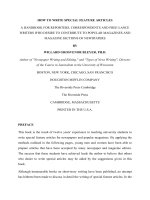how to collect when you win a lawsuit 4th (1999)
Bạn đang xem bản rút gọn của tài liệu. Xem và tải ngay bản đầy đủ của tài liệu tại đây (16.32 MB, 865 trang )
title:
author:
publisher:
isbn10 | asin:
print isbn13:
ebook isbn13:
language:
subject
publication date:
lcc:
ddc:
subject:
Page ii
An Important Message to Our Readers
This product provides information and general advice about the
law. But laws and procedures change frequently, and they can
be interpreted differently by different people. For specific
advice geared to your specific situation, consult an expert. No
book, software or other published material is a substitute for
personalized advice from a knowledgable lawyer licensed to
practice law in your state.
Page iii
How To Collect When You Win a Lawsuit
(formerly Collect Your Judgment)
4th California Edition
By
Gini Graham Scott & Attorney Robin Leonard
Keeping Up to Date
To keep its books up to date, Nolo issues new printings and new
editions periodically. New printings reflect minor legal changes and
technical corrections. New editions contain major legal changes, major
text additions or major reorganizations. To find out if a later printing or
edition of any Nolo book is available, call Nolo at 510-549-1976 or
check our website at www.nolo.com.
To stay current, follow the "Update" service at our website at
www.nolo.com. In another effort to help you use Nolo's latest
materials, we offer a 35% discount off the purchase of the new edition
of your Nolo book when you turn in the cover of an earlier edition.
(See the "Special Upgrade Offer" in the back of the book.)
This book was last revised in: August 1999
FOURTH EDITIONAugust 1999
ILLUSTRATIONSMari Stein
EDITORStephen Elias
COVER DESIGNToni Ihara
BOOK DESIGNTerri Hearsh
PRODUCTIONAni Dimusheva
PROOFREADINGRobert Wells
INDEXJean Mann
PRINTINGBertelsmann Industry Services
Scott, Gini Graham.
How to collect when you win a lawsuit / by Gini Graham Scott,
Robin Leonard Calif. 4th ed.
p. cm.
Includes index.
ISBN 0-87337-498-3
1. Executions (Law)CaliforniaPopular works. 2. Judgments
CaliforniaPopular works. 3. Collection lawsCaliforniaPopular
works. I. Leonard, Robin. III. Title.
KFC1065.Z9S25 1999
347.794'077dc21 98-
34865
CIP
Copyright © 1988, 1992, 1993, and 1997 by Gini Graham Scott,
Stephen Elias and Lisa Goldoftas; 1999 by Gini Graham Scott and
Nolo.com. All Rights Reserved. Printed in the U.S.A.
No part of this publication may be reproduced, stored in a retrieval
system, or transmitted in any form or by any means, electronic,
mechanical, photocopying, recording or otherwise without the prior
written permission of the publisher and the authors. Reproduction
prohibitions do not apply to the forms contained in this product when
reproduced for personal use.
Quantity sales: For information on bulk purchases or corporate
premium sales, please contact the Special Sales department. For
premium sales, please contact the Special Sales department. For
academic sales or textbook adoptions, ask for Academic Sales. 800-
955-4775, Nolo.com, 950 Parker St., Berkeley, CA, 94710.
Page v
Acknowledgments
For the first edition, thanks to:
Attorney Michael Perna (of Marsh and Perna, Oakland,
California) for his valuable suggestions and guidance in
assembling the manuscript.
Attorney Sheldon Greene and the law firm of Greene, Kelley,
Tobriner and Farren (San Francisco, California) for their
generosity in allowing us to use forms and procedures that were
developed for the law firm.
Attorney Irwin Eskanos (of Eskanos and Adler, Oakland,
California) and Judge Allen Norris (Richmond, California) for
their experienced and insightful overviews of the judgment
collection process.
Page vii
Table of Contents
1
How to Use This Book
A. Nineteen Ways to Collect a Court Judgment 1/3
B. Laying the Groundwork 1/3
C. Create a Collections Plan 1/6
D. Special Situations 1/8
E. Miscellaneous Information About Collections 1/16
2
When to Start Collecting
A. How Long Must You Wait? 2/2
B. If You Can't Locate the Debtor 2/5
3
Behavior to Avoid When Collecting
A. Debt Collection Laws 3/2
B. Common Sense 3/2
C. Communicating With the Debtor 3/3
D. Communicating With Others About the Debtor 3/4
E. Giving and Getting Information About the Debtor 3/4
4
Creating Liens on the Debtor's Property
A. Real Estate Liens 4/3
B. Business Asset Liens 4/8
C. Personal Property Liens 4/10
5
Getting the Debtor to Pay Voluntarily
A. Ask for Your Money 5/2
B. Send a Final Demand Letter 5/4
C. Negotiate an Installment Plan 5/5
D. Accept Less Than the Judgment as Full Payment 5/7
E. Respond to the Debtor's Claims of "No Money" 5/8
Page viii
6
Determining What the Debtor Owns
A. Debtor's Statement of Assets 6/2
B. Family Court Records 6/2
C. Schedule a Debtor's Examination 6/2
D. Obtain a Subpena Duces Tecum 6/7
E. Have the Documents Served 6/11
F. Prepare for the Examination 6/12
G. Conduct the Examination 6/12
H. If the Debtor Doesn't Show 6/15
7
Obtaining a Writ of Execution
A. Complete the Writ of Execution Form 7/2
B. Have Court Issue Writ 7/4
C. What to Do With Your Writ 7/4
8
Collecting From Deposit Accounts
A. Finding Banks and Account Numbers 8/2
B. Knowing if the Funds May Be Exempt 8/3
C. Levying on Joint Accounts 8/4
D. How to Levy on Bank Accounts and Safe-Deposit
Boxes
8/5
9
Collecting From Wages
A. Limits on Wage Garnishments 9/2
B. How to Garnish Wages 9/5
10
Collecting From Money or Property Owed to Debtor
A. Locating Money or Property Owed Debtor 10/2
B. How to Levy on Money or Property Held by Third
Parties
10/5
11
Collecting From a Going Business
A. Levying Against Cash Receipts or Business Assets?11/2
B. How to Levy Against Cash Receipts 11/3
C. How to Levy Against Business Assets 11/5
12
Seizing a Motor Vehicle
A. Limitations on Vehicle Levies 12/2
B. How to Levy on a Vehicle 12/4
Page ix
13
Seizing Tangible Personal Property
A. Limitations on Personal Property Levies 13/2
B. How to Levy on Personal Property 13/5
14
Seizing Real Estate
A. Limitations on Real Estate Levies 14/2
B. Finding Debtor's Real Estate 14/2
C. Forcing a Sale of Property 14/4
15
Opposing a Claim of Exemption
A. Wage Garnishment 15/2
B. Property Seizure 15/7
16
Collecting Post-Judgment Costs and Interest
A. Post-Judgment Costs 16/2
B. Post-Judgment Interest 16/4
C. Tracking Your Judgment Balance 16/6
D. Memorandum of Costs 16/7
17
If the Debtor Files for Bankruptcy
A. Types of Bankruptcy 17/3
B. Bankruptcy and Collections 17/4
C. Examine the Bankruptcy Papers You Receive 17/4
D. File Proof of Claim 17/10
E. After Filing the Proof of Claim 17/13
F. What Else Can You Do? 17/14
18
If the Debtor Dies
A. Collecting Through Probate 18/3
B. Collecting Outside of Probate 18/8
19
Help From a Judge: Filing Motions to Force Collections
A. Typical Ex Parte Motions 19/2
B. Typical Noticed MotionMotion for Assignment
Order
19/9
C. After You Prepare the Papers 19/13
D. California Rules of Court 19/15
Page x
20
Collecting an Out-of-State Judgment
A. Turning a Sister-State Judgment Into a California
Judgment
20/2
B. Registering an Out-of-State Support Order in
California
20/10
21
Renewing Your Judgment and Liens
A. Renewing a Judgment 21/2
B. Renewing Liens 21/7
22
Serving Papers on a Judgment Debtor
A. Who Can Serve Papers 22/2
B. Personal Service 22/3
C. Substituted Personal Service 22/5
D. Service by Mail 22/5
E. Proof of Service Form 22/6
23
After the Judgment Is Paid
A. Why File an Acknowledgment? 23/2
B. Complete Acknowledgment Form 23/2
C. Have Your Signature Notarized 23/5
D. Serve and File Acknowledgment 23/5
E. Release Any Liens 23/5
24
Help Beyond the Book
A. Legal Research 24/2
B. Collections Lawyers 24/3
C. Other Collections Professionals 24/5
Appendix
Tear-Out Forms
Index
Page 1/1
Chapter 1
How to Use This Book
A. Nineteen Ways to Collect a Court Judgment 1/3
B. Laying the Groundwork 1/3
1. Set Up a Case File 1/3
2. Establish Liens 1/5
3. Know What You Can and Can't Do 1/5
4. Attempt Voluntary Collection 1/5
5. Find Out About the Debtor's Job and Assets 1/5
6. Obtain Writ of Execution 1/6
C. Create a Collections Plan 1/6
1. Make a Cost-Benefit Analysis 1/6
2. Use Rating Charts 1/7
3. Select One or More Procedures 1/7
D. Special Situations 1/8
1. Judgment From Small Claims Court 1/8
2. Judgment From Federal Court 1/9
3. Judgment Stemming From Motor Vehicle
Accident
1/9
4. Judgment or Order for Child or Spousal Support 1/9
5. You Have a Restitution Order 1/10
6. Debtor Is Married 1/11
7. Debtor Is Government Agency 1/12
8. Debtor Is Federal Employee or on Active
Military Duty
1/13
9. Debtor Is Licensed Contractor 1/13
10. Debtor Is Licensed Real Estate Agent 1/13
Page 1/2
11. Debtor Is Private Vocational School 1/13
12. Debtor Is Subject to Conservatorship or
Guardianship
1/14
13. Judgment Does Not Reflect Debtor's Correct
Name
1/14
E. Miscellaneous Information About Collections 1/16
1. Notify Court of Change of Address 1/16
2. Find Out About Fees and Deposits 1/17
3. Use the Correct Forms and Court Documents 1/17
4. Substitute Yourself for Your Attorney 1/17
5. Know the Lingo 1/17
6. Become Familiar With Legal Citations 1/18
Page 1/3
Congratulations! You have a court judgment ordering someone
to pay you money. You won your small claims court case or
your case in regular civil courta California state court, another
state court or maybe even a federal court. You've spent some
time celebratingafter all, you were wronged and deserve to be
compensated, and a judge, even perhaps a jury, agreed.
But your celebration is not yet a complete one. While the court
decided in your favor, the court did not pay you or demand that
the defendant pull out a check book and pay up. Collecting the
judgment is your job. You may have no idea where or how to
begin. If you've already made some attempts at collecting, you
may be frustrated and feel like you keep hitting a dead end.
It's true that some judgments are uncollectible, but those
judgments are the minority. With information and perseverance,
most people can collect what they are owedwithout having to
hire an attorney and often without much additional expense.
If you don't yet have a court judgment. This book is for people
who already have been to court and been awarded a court
judgment. If you have not yet filed your case or your case is still
pending and you don't yet have a judgment, you'll need to wait
until you get your judgment before using this book. If you
haven't yet filed a lawsuit, take a look at Everybody's Guide to
Small Claims Court, by Ralph Warner (Nolo) or How to Sue for
Up to $25,000 and Win, by Judge Roderic Duncan (Nolo). Of
course, you can read this book while awaiting your day in court
just to prepare for your victory!
A. Nineteen Ways to Collect a Court Judgment
This book covers 19 different ways to collect a court judgment.
The methods are introduced in this chapter and explained in
detail in other chapters. After you read this chapter, you'll need
to read only the portions of the book you think can help you
collect your judgment.
Bankruptcy or death of debtor. If the debtor has either filed for
bankruptcy or died, your collections options are greatly limited.
Instead of reading the rest of this chapter, go directly to Chapter
17 (bankruptcy of the debtor) or Chapter 18 (death of the
debtor).
B. Laying the Groundwork
No matter what type of judgment you have (small claims court
or regular civil court) and what kind of debtor owes you money
(individual or business), several steps will help you immediately
put yourself in the best possible position to collect your
judgment.
1. Set Up a Case File
You may have already organized your documents relating to the
debtor when you were preparing your case for court. Using
those organizational skillsor using new ones if you didn't
arrange anything before going to courtset up a system for all
documents related to your collection efforts. One possible
method is to use an accordion folder for all papers, creating
separate sections for court papers such as the judgment, letters
you write and receipts for costs you incur in trying to collect. If
your collection efforts are extensive, you can set up files by type
of assetsuch as vehicles, bank accounts, real estate and wages.
Keeping complete records is especially important because you
are entitled to collect not only your judgment, but also all
collections costs and accrued interest from the date of the
judgment. Chapter 16 and the Appendix include instructions
and worksheets for keeping track of payments received and
costs and interest due.
Page 1/4
Nineteen Ways to Collect a Court Judgment
Preliminary Steps
1. Place a legal claim (lien) on real estate
Chapter
4
2. Place a lien on business property
Chapter
4
3. Negotiate voluntary payments
Chapter
5
4. Conduct a debtor's examination; can obtain debtor's
money and property at exam
Chapter
6
Basic Collection Techniques (Least costly, generally most
effective)
5. Seize (garnish) wages
Chapter
9
6. Seize (levy on) bank accounts and safe-deposit
boxes
Chapter
8
7. Collect from business debtor's cash register (till tap)
Chapter
11
8. Collect money from business as it comes in, for a
specified time (keeper)
Chapter
11
9. For debtors who file for bankruptcy, file a proof of Chapter
claim 17
10. For debtors who die, file a creditor's claim
Chapter
18
11. Collect (levy on) debts owed by third parties
Chapter
10
12. Suspend driver's license (special situations)
Chapter
1,
Section
D.3
Advanced Collection Techniques (Often expensive, usually
least effective)
13. Seize and sell business assets
Chapter
11
14. Seize and sell vehicle
Chapter
12
15. Seize and sell personal assets
Chapter
13
16. Obtain a court order to seize property located in a
private home
Chapter
19
17. Obtain a court order requiring the debtor to hand
over specific property
Chapter
19
18. Obtain a court order requiring the debtor to assign
(transfer) to you certain rights, such as the right to
receive royalties or federal wages due the debtor
Chapter
19









